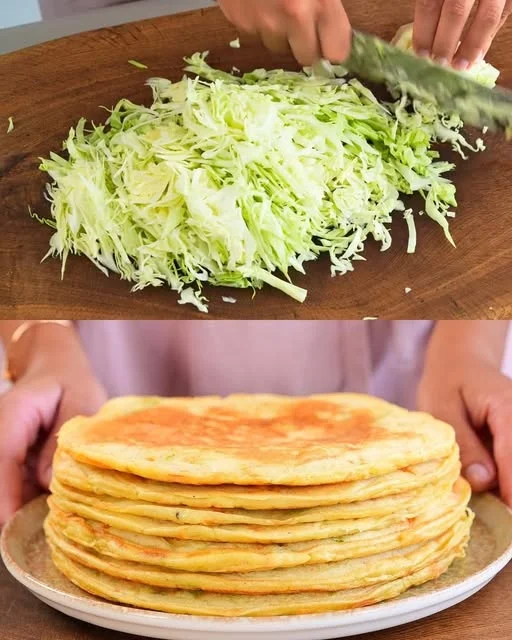I didn’t grow up in a family that celebrated cabbage.
In fact, for most of my life, cabbage was the sad afterthought at the dinner table — boiled too long, barely seasoned, and usually ignored. It wasn’t until I visited my grandmother’s small countryside home that I saw cabbage transformed into something magical. She didn’t boil it. She didn’t steam it. She folded it into fluffy, tangy kefir pancakes and served it piping hot with a dollop of sour cream.
And let me tell you something: I didn’t miss the meat.
It was my first real lesson in the idea that vegetables, when given the right treatment, could sing louder than steak. The cabbage added sweetness and body, while the kefir batter gave the pancakes a light but satisfying texture. They were crispy on the edges, soft in the middle, and impossibly comforting. I didn’t just ask for seconds. I asked for the recipe — and I’ve been making it ever since.
Today, this dish is more than just a clever way to use up cabbage. It’s a reminder that comfort food doesn’t have to be complicated, expensive, or meat-heavy to be deeply satisfying. This recipe has become a staple in my kitchen, and I hope it finds a place in yours too.
Why Kefir Pancakes with Cabbage Deserve a Spot at Your Table
It’s easy to overlook a pancake recipe that doesn’t involve syrup or fruit. But these savory kefir pancakes offer something different — something heartier, healthier, and perhaps even more versatile.
Let’s explore why this recipe is so special:
1. Kefir: The Secret Ingredient for Perfect Pancake Texture
Kefir is a fermented milk product similar to yogurt but thinner and tangier. When combined with baking soda, it reacts beautifully, giving the pancakes lift and lightness without any yeast or long resting time. The result is a batter that creates soft, airy pancakes with crispy edges — even when loaded with hearty cabbage.
2. Cabbage: From Underrated to Unforgettable
Shredded and lightly sautéed, cabbage adds both flavor and structure. It becomes slightly sweet when cooked and softens into the batter in a way that feels indulgent — almost like a filling. If you’ve ever doubted cabbage, this recipe will convert you.
3. Quick and Budget-Friendly
The ingredients are all affordable and accessible, and the batter comes together in minutes. There’s no rising time, no special equipment, and no tricky techniques. It’s the perfect recipe for a busy night or a last-minute lunch.
4. Healthy and Satisfying
With a mix of protein, fiber, and gut-friendly kefir, these pancakes are nourishing as well as filling. They’re naturally vegetarian, and easy to make gluten-free or dairy-free with a few substitutions.
Ingredients
| Ingredient | Quantity |
|---|---|
| Eggs | 2 pcs |
| Salt | To taste |
| Kefir | 450 ml |
| Baking soda | 1 teaspoon |
| Flour | 200 g + 100 g |
| Olive oil | As needed (for frying or batter) |
| Cabbage (optional)* | ~300–400 g, finely shredded and lightly sautéed |
Directions
- Make the Batter
In a bowl, beat the eggs with a pinch of salt. Stir in kefir and baking soda, then gradually add 200 g of flour. If the batter feels too thin, add the remaining 100 g as needed to achieve a thick but pourable consistency. - Add the Cabbage (Optional but Delicious)
For savory cabbage pancakes, sauté shredded cabbage in a little olive oil until soft and golden. Fold it into the batter once cooled. - Pan-Fry to Golden Goodness
Heat a non-stick skillet with a touch of olive oil over medium heat. Pour a ladle of batter into the pan and cook for 2–3 minutes per side until puffed and golden brown. - Serve Hot
Enjoy your pancakes warm, plain or with sour cream, herbs, or a garlic-yogurt dip.
Nutritional (Per Pancake – Approximate, with cabbage)
| Nutrient | Amount |
|---|---|
| Calories | ~110 kcal |
| Protein | ~4 g |
| Carbohydrates | ~12 g |
| Fat | ~5 g |
| Fiber | ~1 g |
| Sodium | ~180 mg |
When and How to Serve Them
One of the joys of these kefir pancakes is their adaptability. They fit into almost any meal scenario:
- Weeknight Dinner: Serve with a side salad and a dollop of yogurt or sour cream for a no-fuss vegetarian main dish.
- Weekend Brunch: Add a poached egg or drizzle of garlic sauce for something a little more indulgent.
- Lunchbox Friendly: Pack them cold with a dipping sauce — they hold up well and don’t need reheating.
- Snack or Appetizer: Make them smaller and serve as finger food or party bites.
- Light Breakfast: They pair wonderfully with tea, especially when reheated and crisped up in a pan.
Tips to Make Your Pancakes Perfect
Even a simple recipe has its tricks. Here’s how to make your kefir cabbage pancakes the best they can be:
Use Fresh, Tangy Kefir
The acidity of the kefir is what reacts with the baking soda to give the batter its rise. If your kefir is flat or expired, the pancakes may not be as fluffy.
Don’t Skip the Sauté
While raw cabbage can be used in a pinch, sautéing it first helps remove excess moisture, concentrates its flavor, and gives the pancakes a better texture.
Watch Your Batter Consistency
The batter should be thick enough to hold its shape on a spoon but still pourable. If it’s too thin, the pancakes will spread and become flat. Too thick, and they won’t cook evenly inside.
Cook Over Medium Heat
Too hot and the outside will burn before the inside is done. Too low and they’ll dry out. Medium heat allows for golden-brown edges and a soft interior.
Rest Before Serving
Let the pancakes rest for a few minutes after frying — it helps the crumb set and makes them easier to handle or stack.
Creative Variations to Explore
Once you master the base recipe, you’ll find yourself playing with variations depending on your cravings and pantry.
Cheese-Stuffed Version
Add a pinch of grated cheese into the batter or even in the center of the pancakes for melty, gooey bites.
Herb-Infused Pancakes
Mix in chopped dill, parsley, or scallions for added freshness and visual appeal.
Spicy Kick
Add chili flakes, black pepper, or a touch of smoked paprika to the batter for a bit of heat.
Gluten-Free Option
Substitute the flour with your favorite gluten-free blend. Just be sure to adjust liquid amounts as needed, since GF flours can vary in absorption.
Dairy-Free Alternative
Use a dairy-free kefir or plain, unsweetened plant-based yogurt thinned with water. Opt for olive oil instead of butter.
Frequently Asked Questions (FAQs)
Can I make these pancakes ahead of time?
Yes! They reheat very well. Store them in the refrigerator for up to 3 days and reheat in a skillet over low heat to restore crispness.
Can I freeze them?
Absolutely. Let the pancakes cool completely, then place parchment between them and freeze in a sealed bag or container. Reheat from frozen in the oven or skillet.
Is kefir necessary, or can I use something else?
Kefir provides the unique tang and rise, but you can substitute with buttermilk or plain yogurt thinned with water. You want the same consistency and acidity.
Can I use red cabbage instead of green?
You can, though it may change the color of the pancakes and give them a slightly different flavor. Green or Savoy cabbage is typically sweeter and softer when cooked.
Can I make these sweet instead of savory?
Yes! Omit the cabbage, add a bit of sugar or vanilla to the batter, and serve with honey, jam, or fruit. It becomes a totally different dish — still delicious.
What do I serve them with?
Sour cream, Greek yogurt, garlicky aioli, herb butter, or even hot sauce all pair beautifully. For a full meal, serve with a side salad or roasted vegetables.
Are they kid-friendly?
Very much so! The mild flavor, soft texture, and slightly sweet cabbage make these pancakes easy to enjoy — especially with a cheesy or creamy dip.
A Recipe That Redefines Comfort Food
There’s something deeply satisfying about taking an overlooked ingredient and turning it into something crave-worthy. In a world where meat is often seen as the center of the plate, these Kefir Cabbage Pancakes remind us that vegetables — when treated with care and creativity — can be just as hearty and soul-satisfying.
They’re budget-friendly, nourishing, and rooted in tradition, but flexible enough to adapt to modern tastes and dietary needs. You can serve them at a fancy brunch, eat them on the go, or enjoy them cold with a dollop of something creamy. They’re the kind of food that feels good — both to cook and to eat.
Final Thoughts: The Power of Simple Things
Not every meal needs to be complicated to be meaningful. Sometimes, the most powerful flavors come from the humblest ingredients. And sometimes, cabbage — yes, cabbage — really does taste better than meat.
This recipe is proof of that.
So the next time you’re staring at that head of cabbage in your fridge, wondering what to do with it, remember this: With a little kefir, a couple of eggs, and a hot pan, you can make something wonderful. Something warm. Something worth remembering.
Because food is more than fuel — it’s memory, tradition, and a little bit of magic folded into every bite.


